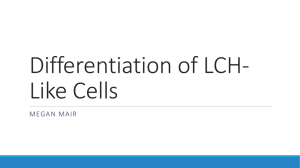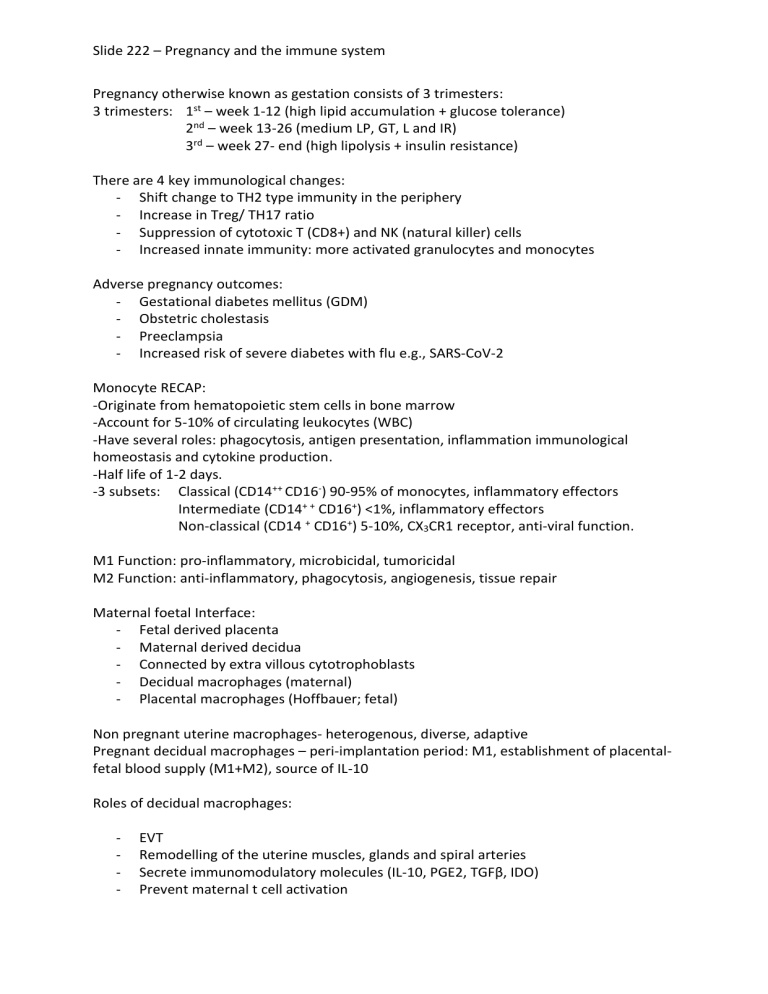
Slide 222 – Pregnancy and the immune system Pregnancy otherwise known as gestation consists of 3 trimesters: 3 trimesters: 1st – week 1-12 (high lipid accumulation + glucose tolerance) 2nd – week 13-26 (medium LP, GT, L and IR) 3rd – week 27- end (high lipolysis + insulin resistance) There are 4 key immunological changes: - Shift change to TH2 type immunity in the periphery - Increase in Treg/ TH17 ratio - Suppression of cytotoxic T (CD8+) and NK (natural killer) cells - Increased innate immunity: more activated granulocytes and monocytes Adverse pregnancy outcomes: - Gestational diabetes mellitus (GDM) - Obstetric cholestasis - Preeclampsia - Increased risk of severe diabetes with flu e.g., SARS-CoV-2 Monocyte RECAP: -Originate from hematopoietic stem cells in bone marrow -Account for 5-10% of circulating leukocytes (WBC) -Have several roles: phagocytosis, antigen presentation, inflammation immunological homeostasis and cytokine production. -Half life of 1-2 days. -3 subsets: Classical (CD14++ CD16-) 90-95% of monocytes, inflammatory effectors Intermediate (CD14+ + CD16+) <1%, inflammatory effectors Non-classical (CD14 + CD16+) 5-10%, CX3CR1 receptor, anti-viral function. M1 Function: pro-inflammatory, microbicidal, tumoricidal M2 Function: anti-inflammatory, phagocytosis, angiogenesis, tissue repair Maternal foetal Interface: - Fetal derived placenta - Maternal derived decidua - Connected by extra villous cytotrophoblasts - Decidual macrophages (maternal) - Placental macrophages (Hoffbauer; fetal) Non pregnant uterine macrophages- heterogenous, diverse, adaptive Pregnant decidual macrophages – peri-implantation period: M1, establishment of placentalfetal blood supply (M1+M2), source of IL-10 Roles of decidual macrophages: - EVT Remodelling of the uterine muscles, glands and spiral arteries Secrete immunomodulatory molecules (IL-10, PGE2, TGFβ, IDO) Prevent maternal t cell activation Slide 222 – Pregnancy and the immune system Placental macrophages – observed before fetal circulation is established (18th day) -Derived from mesenchymal cells -pro-angiogenic - reservoir for ZIKV and other viruses -Last two trimesters – anti-inflammatory -IL-18, TNFα, CCL2, CXCL10, IL-6 – decrease -IL-1RA, sTNFR – increase -More activated CD14, CD64, CD11b -increased TNF⍺ and IL-1β can cause premature labour -produce more oxygen free radicals -Decreased phagocytosis -Conflicting data on cytokine production - Increased non-classical monocytes Preeclampsia: complication in 2nd trimester - Hypertention & proteinuria - Early onset - poor placentation Peripheral monocytes in preeclampsia – increase in CD11b, ICAM-1, CD14, TLR4 -increased reactive oxygen species -increased intermediate monocytes Increased soluble factors from fetal placenta Increased M1, decreased M2 ZIKV - Mosquito borne Outbreaks is suitable weather Mild and non-harmful infection mostly Sexually transmitted More serious for pregnant women – microcephaly, brain defects Mechanism is unclear – can cause placental insufficiency ZIKV neurotropism observed – mice models Changes CD14 to CD16
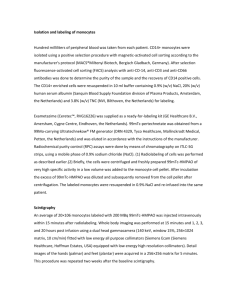
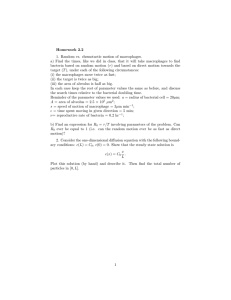
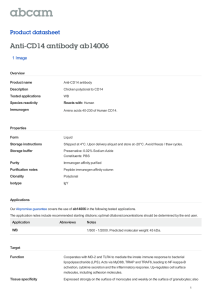
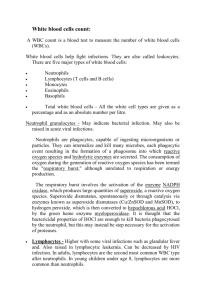

![Anti-Macrophages + Monocytes antibody [ER-HR3] ab59697](http://s2.studylib.net/store/data/012527119_1-585df279932114d3ef5becc6fc52042e-300x300.png)
